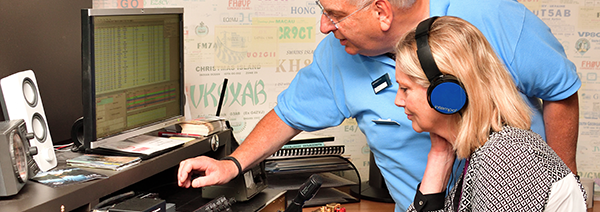Becoming a radio amateur FAQ

The best way to start is by listening to amateurs on the amateur bands. These are frequencies reserved for use by radio amateurs. Try 3.5MHz upwards, or 7MHz upwards for starters. There are ways of doing this even if you have no receiving equipment—see below. Listen to what’s being said, listen to how it’s done and imagine yourself in that place. For a full list of amateur frequencies in the UK see Band Plans and Information.
If you like what you hear, and would like to become a member of of that community, then you can join the RSGB as a listener, and receive the monthly magazine RadCom, which keeps you up-to-date with what’s happening in the world of amateur radio and is full of ideas, advice and useful information. You can then start thinking about getting a licence yourself. It’s easy, and you will find lots of other amateurs only too willing to help you on your way—that’s part of the ethos of being a radio amateur. You can find out more about getting a transmitting licence in these FAQs or by visiting Training.
You'll need a receiver to tune into them, and a suitable antenna, or aerial, which can be as simple as a long piece of wire. If you haven’t got any equipment of your own you can listen to one of the internet software-defined radio (SDR) websites—like the RSGB WebSDR site—which allow you to listen to amateur radio frequencies over the internet. The advantage of listening online is you don’t need special equipment or have to put up aerials. Another useful site is the wide-band SDR at the University of Twente which covers 0-30 Mhz in one band. This enables users to select any part of the shortwave band that they want to listen to. Alternatively, you can go along to your local amateur radio club and ask to listen-in using their equipment. Club members are usually very helpful towards newcomers and can be a very useful source of information for the beginner—i.e. where to find second-hand equipment, which are the best “rigs” to get hold of, how to build your own receiver, etc.
Use our UK Club Finder tool to help you find your nearest club.
There are lots of amateur radio training resources on this website. The RSGB also produces a range of amateur radio tuition materials which you can purchase online.
Any one can listen to the amateur bands, but you'll need a licence to transmit on them. Your first amateur radio licence is the Foundation Licence, which has been designed as an easy-to-achieve goal to help newcomers get on the air quickly. About 12 hours tuition is all that's normally needed to prepare for the examination, and if you have existing knowledge of radio or electronics, it's likely to be much less. You don't need to attend any formal training but you do need to gain enough knowledge to pass the RSGB written examination. The Foundation exam has 26 multiple choice questions to be answered in 60 minutes, of which 19 need to be answered correctly. The RSGB booklet Foundation Licence Manual provides all the information required to take the Foundation Licence examination. There is a set fee for taking the examination, and some venues may charge a small additional fee to cover room hire, etc. If you’re an Air Cadet preparing for your Communicator’s badge and have passed the ACO Equivalent examination, this is accepted by Ofcom as the exact equivalent of the RSGB Foundation examination, and no fee is incurred—you can apply online. There is no lower age limit for taking the examination, but candidates must be able to read and understand the Amateur Radio Licence, the training book, able to recognise and use fractions and decimals and sit a formal examination.
Your completed written paper is marked on the spot wherever you take it, and you'll know soon after handing in your paper if you are likely to have passed or not; although you'll usually have to wait 10 working days for official confirmation from the RSGB Examination Department. If you sit the online examination then you will get an immediate result, but will still have to await the official confirmation to be able to claim your licence from Ofcom.
When you pass your exam you get a candidate number, which is recorded on your pass certificate. You need this number to apply for an amateur radio licence. To apply for your licence go to Ofcom Online Services and create a user account. Login to your new account and follow the Apply for a Licence link. Alternatively, you can download Ofcom form OF346 (11-page/466KB PDF) to apply for an amateur radio licence. Note that applying for a licence online is free but if you send in a paper application a processing fee is incurred. If you applied online you can print your licence and start using your Foundation call sign straight away. If you sent in a paper application, you need to wait until your licence has been delivered through the mail.
The Foundation licence is the entry level to amateur radio, intended to provide an introduction to the hobby while requiring an acceptable minimum level of skill and experience. The Foundation Radio Amateur Examination is the first of three examinations recognised by Ofcom - the UK amateur radio licensing authority - that give access to the amateur radio bands. Once you have your Foundation licence you can start thinking about your next step. There's no pressure to upgrade your licence to the next level, but by training for the Intermediate licence, you'll gain more knowledge and skills. You'll also enjoy additional privileges, including higher power limits and more frequencies, and you'll be permitted to build your own transmitting equipment.










